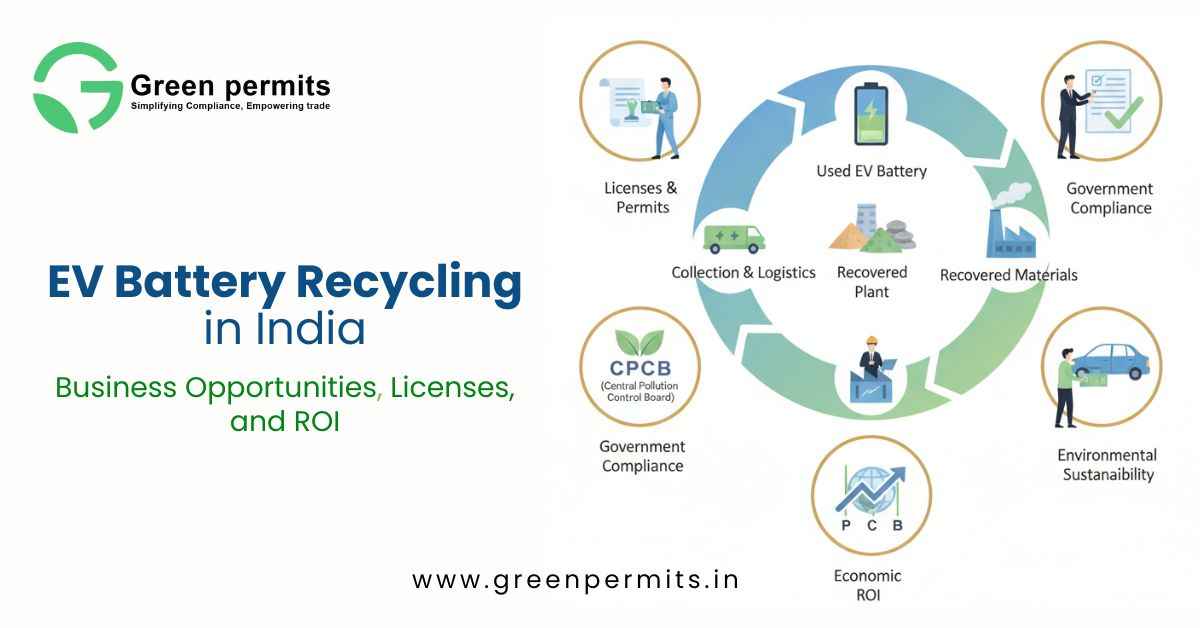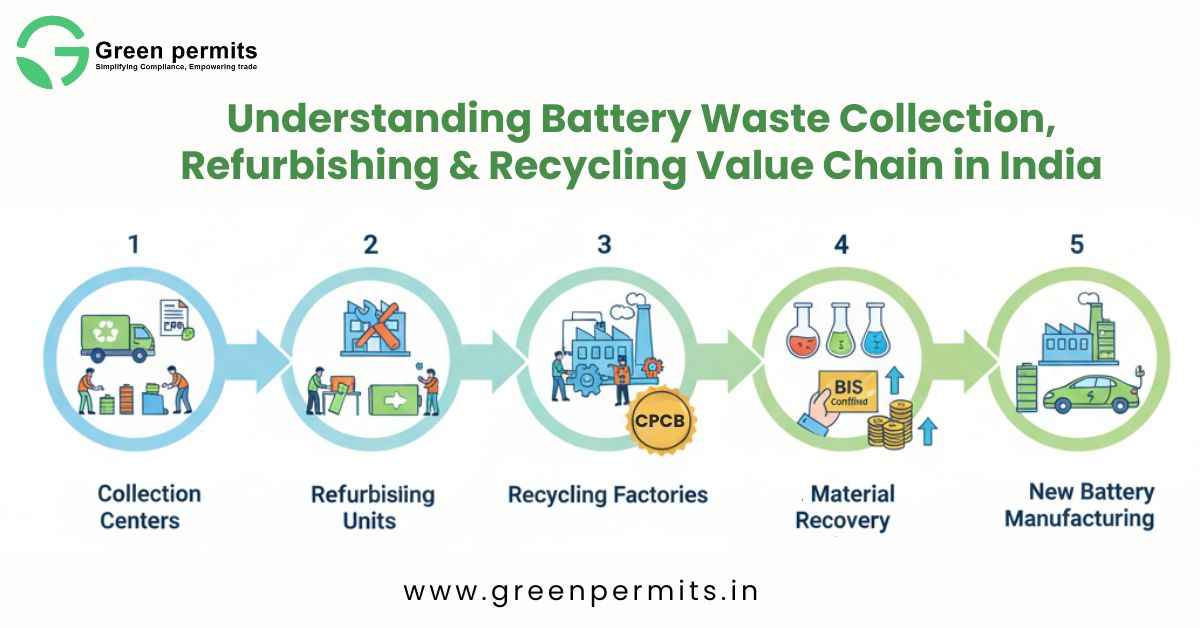A founder’s turning point
When Shashank Verma from Pune decided to enter the EV ecosystem, he assumed setting up a battery recycling plant in India was just about buying the right machines. The surprise came later — permits, environmental clearances, and EPR licensing took longer than the plant construction itself. His experience isn’t unique. Every new recycler discovers that the real cost hides behind paperwork, approvals, and delays.
This guide walks you through what it actually takes in 2025 — from licenses and machinery to incentives and ROI — so you can plan your project with clarity and confidence.
Understanding what drives plant setup cost
The investment for a recycling unit depends on much more than equipment invoices. Think of it as five interlocking pillars:
- Land & Infrastructure: Industrial-zone land, civil construction, power, and water connections form nearly 35–40 % of initial spend.
- Technology Route: Mechanical, hydro-metallurgical, or pyro-metallurgical methods each have different recovery rates and energy footprints.
- Regulatory Compliance: CPCB and SPCB consents, EPR registration, and environmental testing create both direct fees and waiting-time costs.
- People & Processes: Skilled technicians, safety officers, and compliance staff can make or break operations.
- Policy Incentives & Taxes: Duty relief and government recycling incentives announced in 2025 can reduce payback periods by several months.
Every rupee saved or delayed on these levers directly affects your cash flow. Treat them as investment variables, not afterthoughts.
Licenses & EPR: where every journey begins
Setting up a plant without proper environmental permissions is like driving an EV without registration plates. Under the Battery Waste Management Rules (2022 – 2025), every producer, recycler, or refurbisher must be registered on the Central Pollution Control Board (CPCB) portal and track Extended Producer Responsibility (EPR) targets.
What this means in practice
- Registration: File online with CPCB; prepare your process-flow diagram, installed capacity, and safety measures.
- State Consents: Obtain air, water, and hazardous-waste permissions from the State Pollution Control Board (SPCB).
- Annual Returns & Targets: You’ll need a compliance officer or consultant to file monthly data and annual performance.
- Penalties: Delays in reporting or missing EPR targets invite Environmental Compensation (EC) — a financial penalty that can erode margins quickly.
Table 1 — Key compliance checkpoints and cost implications
| Compliance Requirement | What It Involves | Cost Impact |
|---|---|---|
| CPCB Registration | One-time portal registration with documents, site photos, and equipment list | Nominal fee, but 2–4 weeks’ timeline |
| SPCB Consents (Air & Water) | Pollution control systems, stack emission & effluent reports | ₹2 – 5 lakh in setup + renewal every 5 years |
| Environmental Compensation (EC) | Levied for non-compliance or delayed reporting | Typically 1 – 2 % of annual turnover if breached |
| EPR Certificates | Proof of recycling activity sold to producers | Revenue source for recyclers; market price varies |
Takeaway: Treat compliance as a running cost — not just a license fee. Timely filings can save lakhs in EC penalties and build trust with OEM partners.
Machinery & plant sections — choosing the right configuration
A recycling plant runs on precision and safety. Machines must discharge, shred, separate, and refine different chemistries — from lithium-ion to lead-acid — without environmental leakages.
Main cost heads inside the plant:
- Pre-processing zone: Discharging, dismantling, and crushing units that neutralize live cells safely.
- Separation line: Magnetic, air, and hydro classifiers that isolate plastics, metals, and black mass.
- Refining section: Hydro or pyro systems that extract lithium, nickel, cobalt, or manganese.
- Pollution-control area: Bag filters, scrubbers, and wastewater treatment systems.
- Lab & automation: In-house chemical testing and PLC-based monitoring for emissions.
A mid-scale 2,500 TPA plant generally demands ₹25–35 crore including machinery, installation, and utilities. Smaller pilot units can start around ₹8–10 crore, though per-ton costs rise sharply at that scale.
Table 2 — Indicative capital investment (2025 values)
| Capacity (Tonnes per Annum) | Estimated Capex (₹ Crore) | Typical Payback (Years) | Notes |
|---|---|---|---|
| 500 TPA (pilot) | 8 – 10 | 6 – 7 | Suited for R&D or regional collection hubs |
| 2,500 TPA (mid-scale) | 25 – 35 | 4 – 5 | Optimal for state-level recycler |
| 10,000 TPA (full-scale) | 70 – 90 | 3 – 4 | Needs automated line & EPR trading support |
Interpretation: Higher throughput lowers per-ton cost, but only if feedstock contracts and licenses are secured early.
Policy incentives & duty relief that change ROI
Two government measures announced in 2025 are reshaping project economics:
- Import Duty Exemption: Machinery and components for EV battery manufacturing and recycling are now largely duty-free, trimming equipment costs by 5–10 %.
- ₹1,500-crore Recycling Incentive Scheme (FY26–FY31): Recyclers meeting performance standards will qualify for grants or production-linked support.
Together, these moves can raise post-tax IRR by 2–3 percentage points for plants commissioned between 2025 and 2027.
Managing compliance risk — the hidden ROI driver
Consider a recycler in Gujarat who launched operations before renewing state consents. Within weeks, the board issued a closure notice until emissions were proven compliant. The plant stood idle for two months, absorbing salaries, power bills, and interest costs.
Practical safeguards
- Create a compliance calendar aligned with CPCB and SPCB deadlines.
- Maintain a separate reserve fund for unexpected EC charges.
- Document every waste-transfer manifest and test report digitally.
- Engage a consultant for EPR audits instead of last-minute corrections.
Proactive compliance doesn’t just avoid fines — it reassures financiers that your cash flow is predictable.
Building your feasibility & financial model
Before presenting your Detailed Project Report (DPR) or loan application, align the financial sheet with operational milestones:
- Capex Plan: Land + Civil + Machinery + Pollution Control + Working Capital.
- Opex Plan: Power, water, consumables, staff, compliance, and maintenance.
- Revenue Plan: Metal recovery (black mass sales), service contracts, and EPR certificate income.
- Sensitivity Tests: Adjust throughput (±10 %), recovery %, and EPR price band to observe cash-flow stability.
A well-designed model tells investors you’ve accounted for policy shifts and environmental liabilities.
Conclusion — Clarity saves money
Battery recycling is no longer an experimental field; it’s a regulated, policy-backed opportunity. Entrepreneurs who treat compliance as part of strategy, not bureaucracy, consistently achieve smoother commissioning and faster ROI.
Start early.
Finalize land, initiate CPCB registration, and consult technical vendors simultaneously. With upcoming incentives and import duty relief, 2025 is the right year to move from intent to implementation.
📞 +91 78350 06182 📧 wecare@greenpermits.in
Book a Consultation with Green Permits
Book a Technical Call with Expert
FAQs
You must register with CPCB under the Battery Waste Management Rules and obtain Air & Water Consents from your State Pollution Control Board.
They’re calculated on non-compliance duration and impact. Maintaining timely filings usually prevents them altogether.
Yes. Updated EPR certificate pricing and stricter labelling standards slightly raise compliance cost but increase transparency for buyers.
Yes — import duty relief on recycling machinery and a ₹1,500-crore incentive program beginning FY26.
Typically within 4–5 years, depending on throughput, recovery rate, and efficiency of compliance management.



